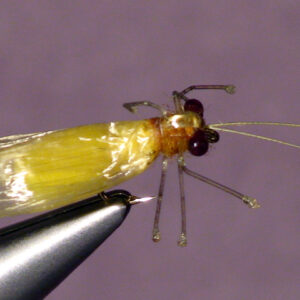Hook Size: 14/16
others in terms of sheer numbers.The species of the Periodidae family, the most important one, differ in size but
their basic color and shape is very similar. Species of the Peltoperlidae family
are shorter and more rounded than the Periodidae species but all the species
within the family are very similar in shape and basic color.Like all stoneflies (with rare exceptions), the Little Yellow Stoneflies crawl out of
the water to hatch. The nymphs are much more susceptible to being eaten by
trout when they migrate from their normal locations down in between and under
rocks on the streambed to the banks to hatch.
When there is no hatch taking places, the stoneflies are basically safe from the
trout. It is not unusual for one to become dislodged and to subject to being
eaten. They don’t show up that regular in drift samples; however, and I doubt it
is a frequent occasion. Behavioral drifts, which usually occur under low light
conditions or during the night, don’t have substantial numbers of stonefly
nymphs.
There are so many different species of stoneflies including the Little Yellow
species, there is a hatch occurring more often than you would think. The bottom
line to this is that your odds of success are good if your are fishing stonefly
nymph imitations most any time. Trout eat them whether they are hatching or not.
Of all the Little Yellow species, the Yellow Sallies provide the best opportunity for
anglers. They often deposit their eggs during the daytime, whereas many other
stonefly species do so during the evening hours.All of the species of these two families of stoneflies live in fast water. They must
have fast flowing, clean water to survive. Prior to the hatch, the Little Yellow
Stoneflies will move along the bottom from their fast water habitat to the banks to
hatch. Some of them crawl up on stones that protrude out of the water to hatch
but the majority use the banks. Just as soon as they get out of water, they shed
their shucks and fly away. The best chance the trout have to eat them is during
this migration prior to the hatch. Often, the trout will actually intercept them
along the banks.
These different species of Little Yellow Stoneflies hatch at different times of the
year depending on which species. Most of the Yellow Sallies, or species of the
isoperia genus, hatch in the Summer. The nymphs will crawl to the banks in the
afternoons if it is heavily overcast. The later in the day, the better the fishing
usually is, but you can take trout imitating the migrating nymph anytime during
the afternoon is a hatch is in progress.
If you walk up to the bank and cast or if you walk up to the bank and wade into
the water, you may have spooked the trout you are trying to catch. Where
the trees and bushes allow, you should first cast to the banks from a short
distance away from the banks. Bring the nymph on the bottom all the way back
to the bank. Remember, the trout do not have to see you to spook. If you are not
careful, they can hear you walking on the bank close to the water through their
lateral line. Ease up to the stream as quietly as possible without kicking rocks,
etc. When you do get in the water, wade away from the bank about a rods length
and fish the nymph down and across allowing the nymph to swing back to the
bank. This will work much better than a up stream cast.
Continue to move downstream a foot or two each cast covering all of water along
the bank. If you cast out a few feet, say ten or fifteen feet using a reach cast that
ends with your rod pointing towards mid-stream, you can slowly swing the rod
back in the opposite direction pointing it towards the bank. This will swing the fly
from several feet out in the stream all the way to the bank. In other words you
can cover approximately twenty to thirty feet of water each cast. Of course, this
changes with the particular stream and stream composition. If there is a run near
the bank, you may only need to swing the fly a few feet.
You will need to make longer cast than you are probably used to making in small
streams. You need to keep the fly twenty feet or more away from you depending
on the water. In shallow water you may need to keep the fly thirty feet or more
from you to keep from spooking the trout. Remember, the trout will be facing you
when you fish downstream.
Make sure you keep the fly on the bottom. If it is swinging up off the bottom
mid depth or near the surface, you are not going to catch many fish. Weight it
down and keep it right on the bottom. When you pick it up slightly off the bottom,
the fly will swing towards the bank a few inches. Let it get back on the bottom
before you lift the rod again.
Copyright 2013 James Marsh

